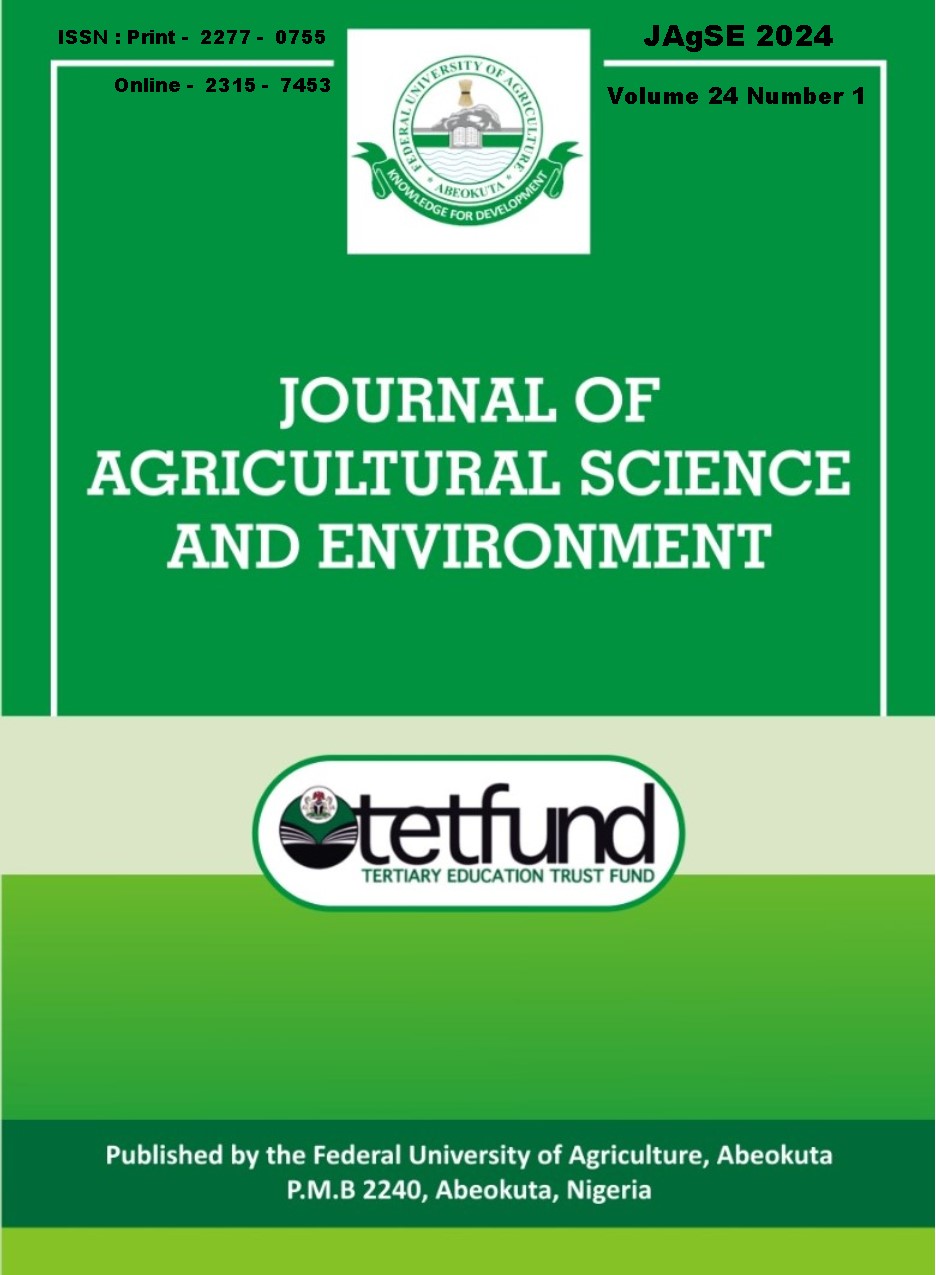IDENTIFICATION AND GENETIC DIVERSITY OF TOMATO (Solanum lycopersicum L.) GERMPLASMS IN IBADAN METROPOLIS, NIGERIA
Keywords:
Tomato, landrace, classification, molecular biology, crop improvementAbstract
The adoption of invasive tomato cultivars by peasant farmers has led to a decline in the cultivation of landraces. Presently, a huge number of tomatoes in Ibadan, Oyo State, Nigeria are either hybridized or foreign cultivars which are difficult to identify and classify. It is likely that new varieties may have arisen through anthropogenic influences and natural hybridization. This negligence of landraces has contributed to the limitation on the extent of their genetic diversity for effective breeding and conservation for present and future uses. Consequently, six tomato germplasms were collected from local farmers in Ibadan and had their genetic diversity assessed for improvement, identification, and documentation purposes. The germplasms had their young leaves subjected to DNA extraction, PCR analysis, Sanger sequencing at Inqaba Biotec West Africa, Ibadan. Basic Local Alignment Search Tool (BLAST) was used to confirm the identity of the landraces on the NCBI Genbank. The nucleotide sequences submitted to GenBank were assigned accession numbers: OR809185.1, OR809186.1, OR809187.1, OR809188.1, OR809189.1, and OR809190.1. The Bootstrap phylogenetic tree revealed genetic and evolutionary variation among accessions. The result of BLAST confirmed the identities of the germplasms with accessions in the Genbank as Grape tomato, Heirloom tomato, Red Brandywine, Red Beefsteak, and Cherry tomato for OR809185.1, OR809186.1, OR809187.1, OR809188.1, OR809189.1, and OR809190.1, respectively. The finding showed that variation by phylogenetic tree could be a potential source of genetic diversity for tomato crop improvement. It also documented Grape tomato, Grape tomato, Heirloom tomato, Red Brandywine, Red Beefsteak, and Cherry tomato as tomato varieties available in Ibadan metropolis.
References
Adedeji, O. K., Taiwo, C., Akanbi, W. A., Ajani, R. 2006. Physicochemical properties of four Tomato cultivators grown in Nigeria. Journal of Food. 30(1): 79-86.
Agudelo, A. G., Ceballos, N., Orozco, F. J. 2011. Morphological characterization of the cherry tomato (Solanum lycopersicum L.) Agronomy, 19: 44-53.
Al-Alysh, F., Kutma, H., Al- Zouabi, A. 2012. Genetic variation, heritability, and interrelationships of some important characteristics in Syrian tomato landraces (Solanum lycopersicum L.). Academia Arena, 4:1-5.
Bello, A. O., Oladipo, O. T., Saheed, S. A. 2013. Numerical taxonomic study of some Solanum L. species (Solanaceae) using vegetative and floral morphological characters. Ife Journal of Science, 15(3): 523-534.
Chen, Y., Zhu, X., Loukopoulos, P., Weston, L. A., Albrecht, D. E., Quinn, J. C. 2021. Genotypic identification of Panicum spp. in New South Wales, Australia using DNA barcoding. Scientific Reports 11(1):16055.
Ebimieowei, E. and Ebideseghabofa, E. 2013. Postharvest Quality of Commercial Tomato (Lycopersicon esculentum Mill.) Fruits Brought into Yenagoa Metropolis from Northern Nigeria. Journal of Biology, Agriculture and Healthcare, 3(11): 23-32.
Kumar, S., Stecher, G., Li, M., Knyaz, C. and Tamura, K. 2018. MEGA X: Molecular Evolutionary Genetics Analysis across computing platforms. Molecular Biology and Evolution, 35:1547-1549.
Labate, J. A., Robertson, L. D. 2012. Evidence of cryptic introgression in tomato (Solanum lycopersicum L.) based on wild tomato species alleles. BMC Plant Biology, 12: 133.
Mazzucato, A., Papa, R., Bitocchi, E., Mosconi, P., Nanni, L., Negri, V., Picarella, M. E., Siligato, F., Soressi, G. P., Tiranti, B., Veronesi, F. 2008. Genetic diversity, structure and marker-trait associations in a collection of Italian tomato (Solanum lycopersicum L.) landraces. Theoretical and Applied Genetics.,116:657-669.
Naim, D. M., Mahboob, S. 2020. Molecular identification of herbal species belonging to genus Piper within family Piperaceae from northern Peninsular Malaysia. Journal of King Saud University Science, 32(2):1417–1426.
Olayemi, C. A. 2000. The Tomato crop: A Scientific Basis for Improvement Chapman Hall LTD, University Press Cambridge 75pp.
Onifade, T. B., Aregbesola, O. A., Ige, M. T. and Ajayi, A. O. 2013. Some Physical Properties and Thin Layer Drying Characteristics of Local Varieties of Tomatoes (Lycopersicon lycopersicum). Agriculture and Biology Journal of North America., 4(3): 275-279.
Osei, M. K., Bonsu, K. O., Agyeman, A. and Choi, H. S. 2014. Genetic diversity of tomato germplasm in Ghana using morphological characters. International Journal of Plant Soil Science, 3: 220–231.
Oyelakin, A. S., Olabiyi, D. O., Wang, L., Cao, Y., Idehen, E. O. 2019. Genetic Diversity of Capsicum (L.) Accessions from Southwest Nigeria using Simple Sequence Repeats (SSR) Markers. Pertanika Journal of Tropical Agricultural Science (JTAS), 42(4): 1273-1288.
Oyelakin, A. S., Olabiyi, D. O., Amaogu, C. C. and Olabisi, A. O. 2021. Morphological Characterization on Accessions of Pepper (Capsicum annuum L. and Capsicum frutescens L.) cultivated in Nigeria. Feddes Repertorium, 132(4): 346-363.
Peralta, I. E., Spooner, D. M. 2005. Morphological characterization and relationships of wild tomatoes (Solanum L. Section Lycopersicon) Monogr. Systematic Botany, 104:227-257.
Popoola J. O., Eruemulor, D. I., Ojuedrie, O. B., Oyelakin, A. S. 2023. Dataset on estimate of intra-specific genetic variability of African yam bean (Sphenostylis stenorcapa (Hochst. ex A. Rich.) Harms) based on rbcl gene marker. Data in brief, 47. 108944.
Qumer, I., Muhammad, Y. S., Amjad, H., Muhammad, A. 2014. Assessment of genetic divergence in tomato through agglomerative hierarchical clustering and Principal Component Analysis. Pakistan Journal of Botany, 46(5): 1865-1870.
Saeed-Awan, M., Hussain, A., Tanveer Abbas, T., Karim, R. 2012. Assessment of Production Practices of Small Scale Farm Holders of Tomato in Bagrote Valley, CKNP Region of Gilgit-Baltistan, Pakistan. Acta agriculturae Slovenica, 99(2): 191-199.
Song, J., Chen J., Chen, H. Y., Liu, Y. Zhuang, T. M. 2006. Research of genetic diversity of tomato using SSR markers. Journal of Shanghai Jiao Tong University, 24:524−528.
Terzopoulos, P. J., Bebeli, P. J. 2010. Phenotypic diversity in Greek tomato (Solanum lycopersicum L.) landraces. Scientia Horticulturae, 126(2):138-144.
Zhang, X., Zhang, Z., Gu, X., Mao, S., Li, X., Joël, C., Alain, P., Wang, L., Zhang, B. 2016. Genetic diversity of pepper (Capsicum spp.) germplasm resources in China reflects selection for cultivar types and spatial distribution. Journal of Integrative Agriculture 15(9): 1991- 2001


